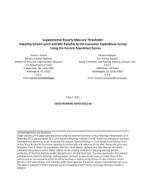
An official website of the United States government
Here’s how you know
Official websites use .gov
A .gov website belongs to an official government organization in the United States.
Secure .gov websites use HTTPS
A lock (
) or https:// means you’ve safely connected to the .gov website. Share sensitive information only on official, secure websites.
-
//
- Census.gov /
- Library /
- Census Working Papers /
- Supplemental Poverty Measure Thresholds
Supplemental Poverty Measure Thresholds: Imputing School Lunch and WIC Benefits to the Consumer Expenditure Survey Using the Current Population Survey
Supplemental Poverty Measure Thresholds: Imputing School Lunch and WIC Benefits to the Consumer Expenditure Survey Using the Current Population Survey
Abstract
In March 2010 an Interagency Technical Working Group (ITWG) released guidelines on thresholds and resources for a Supplemental Poverty Measure (SPM). The ITWG recommended that thresholds include in‐kind benefits that are accounted for in resources; however, only limited in‐kind benefit information is available in the Consumer Expenditure Survey (CE) Interview component, the data source upon which the thresholds are based. For example, the CE collects information on food expenditures that implicitly include the cash value of benefits from the Supplemental Nutrition Assistance Program (SNAP) but no information on other food programs. This study introduces a new method, the CPS Program Participation Method, of imputing benefits for the National School Lunch Program (NSLP) and the Women, Infants, and Children program (WIC). In this study, data from the Current Population Survey (CPS), the data source upon which the SPM resource measure is based, are used to model the participation of CE households in the NSLP and WIC using the CPS Program Participation Method. These CPS-based participation rates for NSLP and WIC are then used along with U.S. Department of Agriculture information to assign benefit levels to the CE households. Thresholds based on the CPS Program Participation Method are produced for 2009 and compared to thresholds based on a method based on program eligibility guidelines, the CE Eligibility Method. SPM thresholds are produced by housing types as well as overall. No poverty rates using these thresholds are produced.
Results reveal that the CE Eligibility Method overall threshold is higher than the CPS Program Participation Method overall threshold. This is not surprising since the CE threshold is based on eligibility while the CPS threshold is based on program participation. The paired CE and CPS based thresholds are also statistically significantly different from each other for owners with mortgages and for owners without mortgages. When housing tenure thresholds are compared to each other within each method group, statistically significant differences arise for two of the three pairs of thresholds. In particular, the thresholds for owners without a mortgage were found to be different from the thresholds of both owners with a mortgage and renters, while the thresholds for owners with a mortgage and renters did not differ from each other at the significance levels used for testing.
Others in Series
Working Paper
Working Paper
Working Paper
Share
Related Information
WORKING PAPER
Supplemental Poverty Measure Working PapersSome content on this site is available in several different electronic formats. Some of the files may require a plug-in or additional software to view.
 Yes
Yes
 No
NoComments or suggestions?


Top

